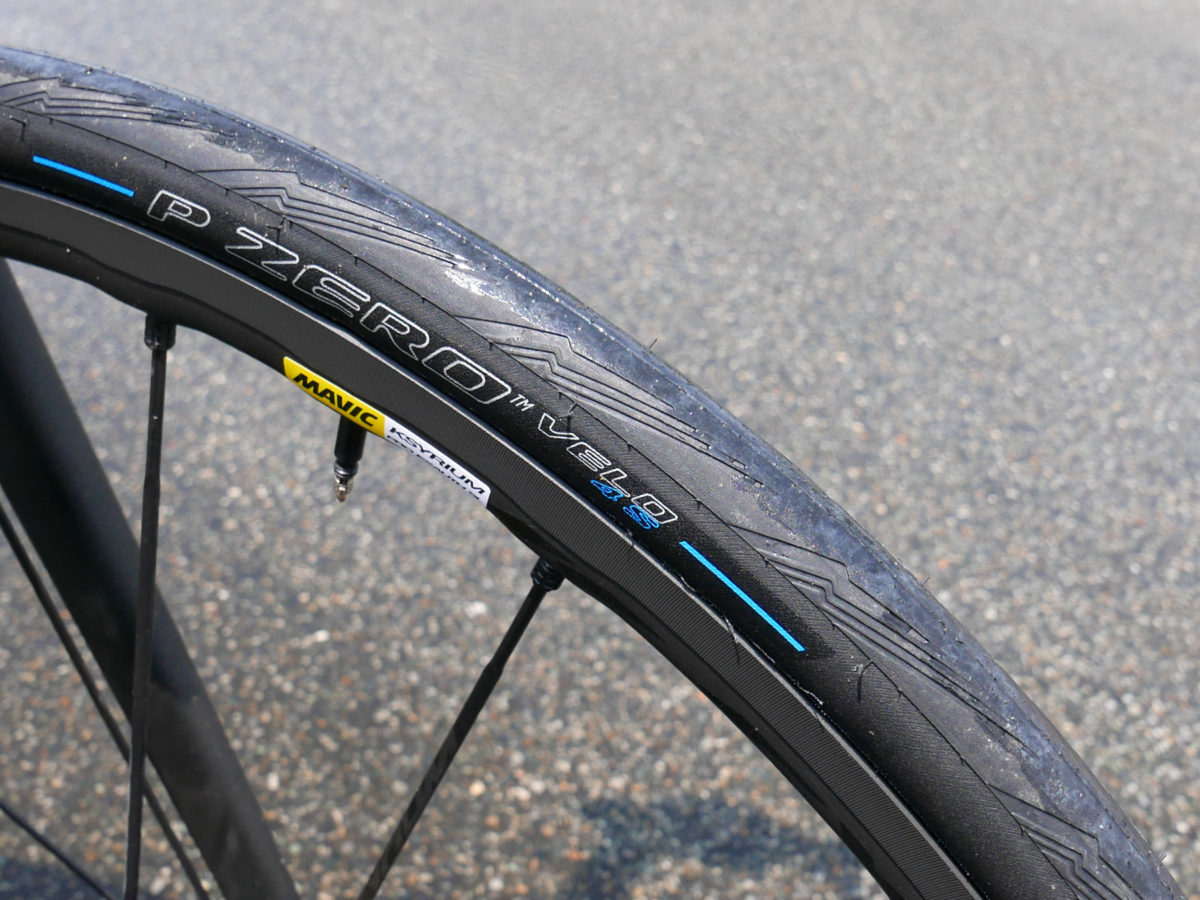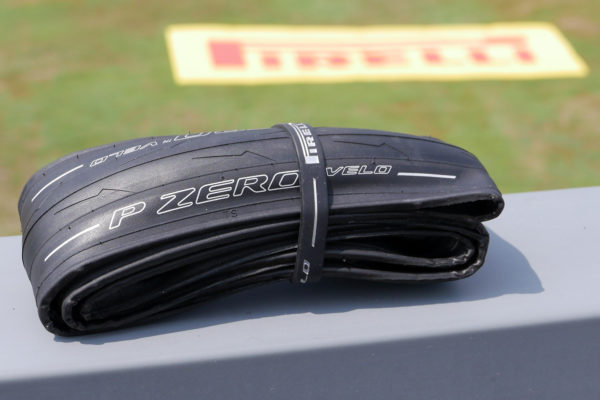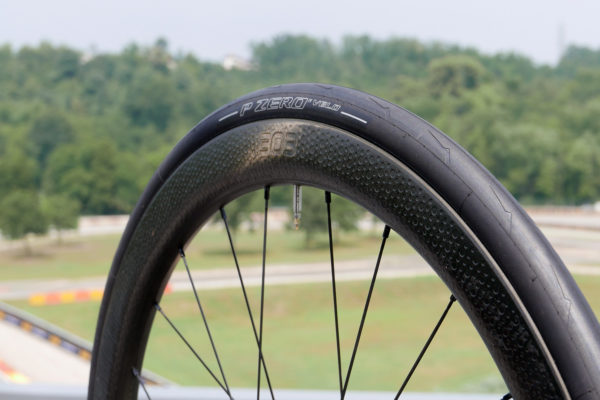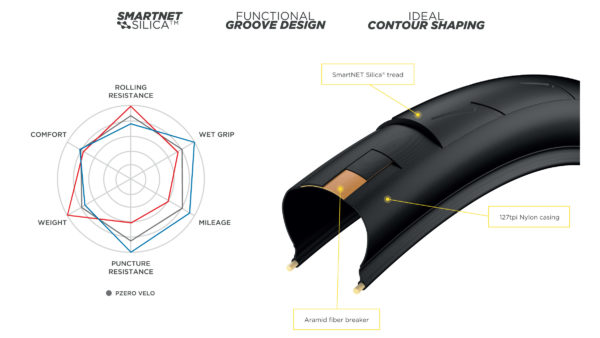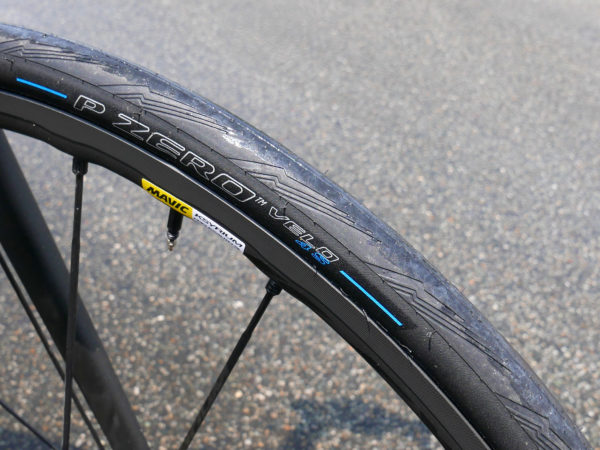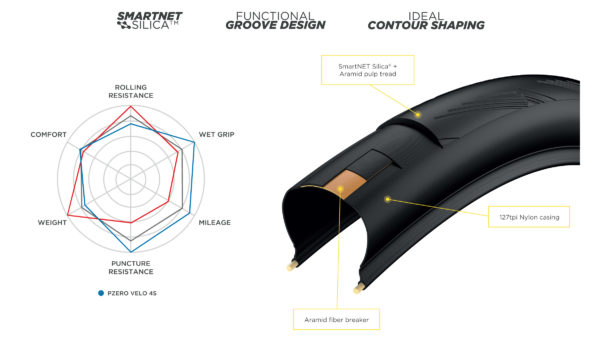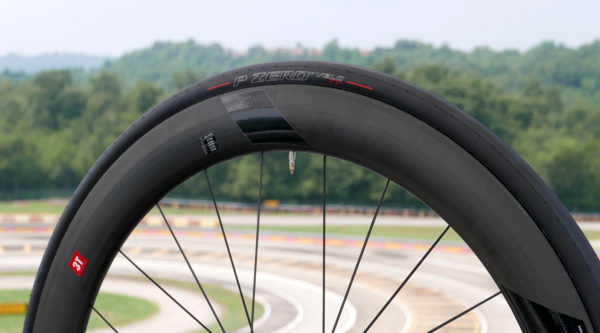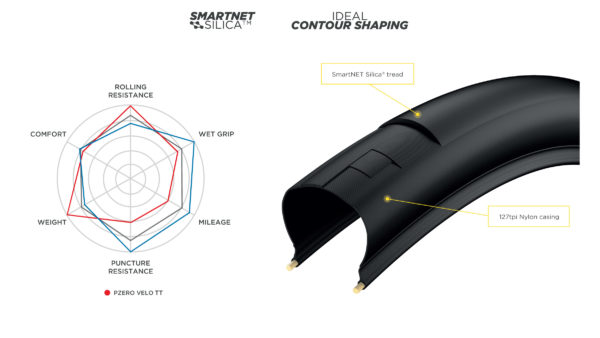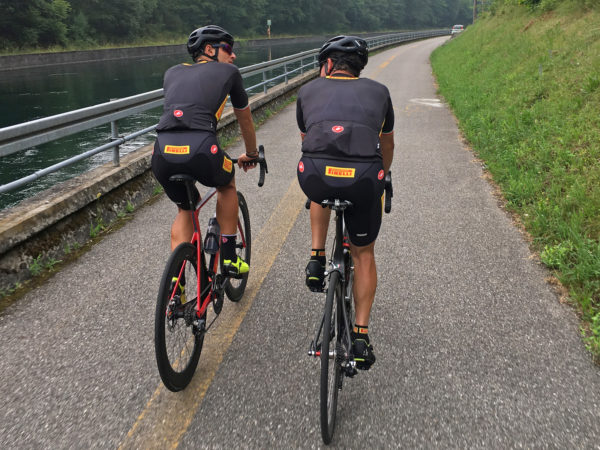Almost half a century out of serious bicycle racing, the premier Italian tire maker is making a return to the road bike with three new nanotechnology infused race tires. They teased us back in May, but now we have the details. Carrying the top-level PZero name from their motorsport racing tires, Pirelli have developed unique Silica nanotech reinforced rubber compounds for a new PZero Velo range, promising an industry-leading balance of low rolling resistance, durability & wet weather grip. Pirelli is exclusively targeting race-level performance, but starting out with a set of reasonably priced road tires aimed at the amateur rider. Take a close look at the PZero Velo, TT & 4S tires after the break where we’ll dig into the SmartNet Silica tech that makes them tick…
We know the Pirelli brand well for performance car & motorcycle tires, but in fact they had been producing some of the first bicycle tires all the way back in the 1890s. They produced Grand Tour winning road tires though the 1960s but eventually moved focus to motorsports. Now after more than two years of development, Pirelli are adapting their expertise back to the bike with a three tire range. The Zero Velo, Zero Velo TT, and Zero Velo 4S hope to give road cyclists new performance clincher options that promise best-in category performance from tires that are competitively priced.
From the outside the tires don’t look much different from what we’ve come to expect with smooth to lightly grooved tread profiles and 23-28mm offerings, but it is inside that they pack a few different tech features that claim to truly boost performance. The key tech of the three tires essentially breaks down to advanced nanotech Silica infused rubber compounds, the integration of technical grooved treads adapted from the motorcycle, and precisely designed tire profile.
The SmartNet Silica is the real standout component of the new tires. The proprietary rubber compound is made up of 22 different elements mixed together, including key Silica nano technology in an application similar to what we saw with Vittoria’s Graphene+. But instead of working with nano-scale graphite, Pirelli is using a synthetic Silica manufactured to create consistently long & narrow nano-sized rods that can be oriented in the total rubber matrix (anisotropicly, or rather aligned with rotation) to do the counter intuitive of both decreasing rolling resistance and improving cornering & wet weather grip.
Everyone in the materials industry these days is talking about nano tech. But even though Pirelli is effectively a newcomer to cycling tires and quite small as a bike tire maker, they have an unsurprisingly strong chemistry & material science capability through their motorsports tire development that could easily cross over to cycling. That seems to have greatly benefited Pirelli’s cycling R&D as they already had the experience and know-how from premium motoring tires applying this same type of nanotech.
Then to create a cycling specific application they took the Functional Groove Design that they developed for motorcycling and again adapted it for the bike. Less about clearing debris away the stepped, variable depth & direction Flash grooves that have almost become a trademark for the brand, actually are designed to provide a controlled amount of flex of the rubber surface to more readily deform and grip the road surface as your corner.
With a smooth rolling center section for the treads, the alternating grooves side-to-side maintain tire stiffness but deform the most through a medium lean man angle for the most impact to road contact, and decrease again to a smooth stable surface for the most support at maximum lean angles.
Pirelli also adapted a tire profile shape from motorcycling as well, developing a 127tpi casing to achieve a contour with two different radii to optimize (and actually be able to change) the shape of the tire’s contact patch at different lean angles. Its something we presume some other tire makers have come to as well through layered tire construction, but the way Pirelli seems to have focused on controlling the tire profile through leaning by way of computer simulation and real world contact patch scanning highlights a unique focus the company has essentially as an outsider to top-level cycling for many years.
Each of the three tires (and just 7 total variants) have been entirely designed & prototyped in Pirelli’s high tech Milan HQ, along side tires destined for F1 cars, Lamborghinis, and Ducatis. From the chemical rubber compositions to tread & casing designs, to the actual production techniques, Pirelli has used decades of motorsport racing expertise to turn the cycling-unique deigns into reality. Pirelli creates all of their own proprietary rubber compounds in their factory in Romania so they can control the technology, then the tires themselves are produced under contract in France by a parter with the existing capacity. That partner appears to be Hutchinson who also makes Mavic tires, and Pirelli says that it has been a mutually beneficial relationship that allows them both to increase the economy of scale of manufacturing road bike tires.
PZero Velo
Of the three tires, the PZero Velo wants to set a new standard for a race-level clincher, designed to balance excellent handling and low rolling resistance efficiency with grip in the wet and even puncture resistance. It achieves most of that through the use of the nanotech SmartNet Silica reinforced rubber, as well as an aramid fiber anti-puncture belt.
It also gets the Flash groove design and the tire profile shaping for consistently high performance through cornering. The flagship PZero Velo is available in 23, 25 & 28mm widths at claimed weights of 195, 210, 230g, respectively. The 23 & 25mm tires are to be available to consumers in August 2017 with a retail price of 43€. The 28mm version is expected to be delivered about one month later, and will sell for ~46€.
PZero Velo 4S
While the standard tire claims excellent grip in the wet, the PZero Velo 4S or Four Season is said to boost grip even more by about 7% with a slightly stickier rubber compound. It also gets added anti-puncture protection and a more pronounced set of Flash grip grooves.
The 4S is still a fairly light and fast rolling tire. Available again in 23, 25 & 28mm versions it adds just a few grams over the more race focused tire to claimed 205, 220 & 250g, respectively. The two narrower versions should retail for ~46€, while the 28s will be the most expensive tire at 49€, with early August availability for all sizes.
PZero Velo TT
For those looking for the absolute lightest tire, with the lowest straight line rolling resistance the PZero Velo TT could be the choice. The tire keeps the same nanotech Silica rubber compound of the standard tire, but drops the grooves for less resistance (or cornering grip).
Intended mostly for the weight weenie racing against the clock the TT comes in just a 23mm width, with a claimed 165g weight and no anti-puncture protection.
We’ve had a chance to put in a little bit of ride time in on the standard 25mm PZero Velo clincher around the roads and wet/dry Pirelli test track outside of their Milan HQ. So far we’ve come away with a promising first look at the tires’ performance, delivering as advertised on both dry and wet tarmac. Pirelli sees a lot of value in their reputation, and appears to have done their homework with this tire introduction. They’ve intentionally kept the range small to give cyclists a chance to get a first impression what they are capable of.
And pricing has been intentionally set at a reasonable & realistic level. While you might see tires from some companies like Conti or Michelin that have list prices in the ~75€ range but regularly sell online for ~40€, that is something Pirelli doesn’t want. This roughly 43€ cost per tire will stay the same no matter where you look to buy them, offering a real & reliable value to riders.
The choice of this 23-28mm road race & all season range was picked as the type of tires most road riding amateurs are actually using these days, but is clearly though of as a starting point. Pirelli assured us that they have road tubeless tires already in the works, and there was talk about tubulars & discussions with at least two pro teams for the immediate future. When we asked what the thought about wider road tires, CX, XC, and even DH disciplines the answer from the product development side was pretty clearly ‘sure we are working on all of that’. Pretty much every racing discipline seems like fair game for Pirelli, they just aren’t going to jump in until they’ve proven themselves a bit first, and take the time to develop more tires to their own exacting standards.
Keep an eye out and we’ll get more into our first riding impressions in the coming days.
